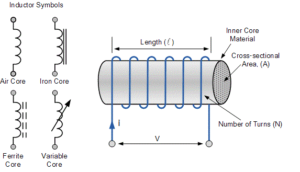
Courses

By Shailendra Singh
|
Updated on 20 Mar 2025, 15:50 IST
An inductor, also known as a coil or a reactor, is a passive electrical component that stores energy in a magnetic field when electric current flows through it. Inductors are typically made by winding a conducting wire (often copper) into a coil. When a current passes through this coil, it generates a magnetic field around it, and any change in the current causes a corresponding change in the magnetic flux. This change in flux, in turn, induces an electromotive force (EMF) in the coil itself, opposing the current change.

The behavior of an inductor is fundamentally governed by Faraday’s Law of Electromagnetic Induction, which states that any change in magnetic flux through a conductor induces a voltage (EMF). The faster the current changes, the greater the induced voltage.
In addition, Lenz’s Law determines the polarity of this induced voltage. It ensures that the induced voltage always opposes the change in current. For instance, if the current increases, the inductor will generate an opposing voltage that resists this increase. If the current decreases, the inductor will produce a voltage that tries to maintain the original current level. This opposition to current fluctuation is a hallmark property of inductors, making them valuable for stabilizing circuits.
The property that quantifies an inductor’s ability to oppose changes in current is known as inductance. Inductance, denoted by the symbol LLL, is measured in henries (H). A henry is defined as the inductance of a circuit in which a change in current of one ampere per second induces an EMF of one volt. In practice, inductors can range in value from a few microhenries (μH\mu HμH) in small signal circuits to several henries in larger power applications.
| Inductor Type | Core Material | Typical Inductance Range | Common Applications |
| Air-Core Inductors | Air (no core) | μH\mu HμH to mH | High-frequency applications, RF circuits |
| Iron-Core Inductors | Laminated iron | mH to H | Power supplies, transformers |
| Ferrite-Core Inductors | Ferrite | μH\mu HμH to H | EMI filters, switching power supplies |
An inductor is not just a coil of wire; its design and materials influence its performance. The core material plays a critical role in determining the inductor’s properties. Common core materials include air, iron, and ferrite. While air-core inductors have no magnetic material and thus no core losses, iron and ferrite cores enhance the magnetic field strength, increasing the inductance without requiring additional turns of wire.
Modern inductors are also designed with attention to their physical size, resistance, and frequency response. High-frequency inductors often use ferrite cores due to their low losses at high frequencies, while iron cores are more common in low-frequency, high-power applications.
Inductors are indispensable in a wide variety of electrical and electronic systems. Some key applications include:
Advantages:

Limitations:
As electronics continue to shrink and operate at higher frequencies, there is ongoing research into developing inductors with smaller footprints and improved performance. Nanocrystalline and amorphous materials are being explored to reduce core losses, while advanced manufacturing techniques, such as printed circuit board (PCB) embedded inductors, aim to integrate inductance directly into the circuit, minimizing size and improving efficiency.
Inductors are crucial components in modern electronics, providing energy storage, noise suppression, and frequency selection. From power supplies to communication systems, their ability to resist current changes and store magnetic energy underpins their value. As technology evolves, so too does the design and application of inductors, ensuring their continued relevance in the ever-advancing world of electrical engineering.

Inductors are typically used for the following reasons in electrical power and electronic devices: High-frequency noise in electrical circuits involves choking, obstructing, attenuating, or filtering/smoothing. Energy is stored and transmitted in power converters (dc-dc or ac-dc).
A passive electrical component called an inductor stores energy in the form of a magnetic field. An inductor is a wire loop or coil in its most basic form. The coil's inductance is proportional to the number of turns it has.